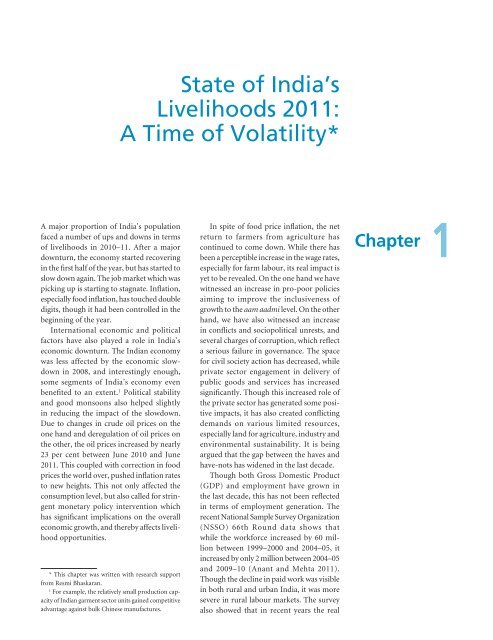State of India’sLivelihoods <strong>2011</strong>:A Time of Volatility*A major proportion of India’s populationfaced a number of ups and downs in termsof livelihoods in 2010–11. After a majordownturn, the economy started recoveringin the first half of the year, but has started toslow down again. The job market which waspicking up is starting to stagnate. Inflation,especially food inflation, has touched doubledigits, though it had been controlled in thebeginning of the year.International economic and politicalfactors have also played a role in India’seconomic downturn. The Indian economywas less affected by the economic slowdownin 2008, and interestingly enough,some segments of India’s economy evenbenefited to an extent. 1 Political stabilityand good monsoons also helped slightlyin reducing the impact of the slowdown.Due to changes in crude oil prices on theone hand and deregulation of oil prices onthe other, the oil prices increased by nearly23 per cent between June 2010 and June<strong>2011</strong>. This coupled with correction in foodprices the world over, pushed inflation ratesto new heights. This not only affected theconsumption level, but also called for stringentmonetary policy intervention whichhas significant implications on the overalleconomic growth, and thereby affects livelihoodopportunities.* This chapter was written with research supportfrom Resmi Bhaskaran.1For example, the relatively small production capacityof Indian garment sector units gained competitiveadvantage against bulk Chinese manufactures.In spite of food price inflation, the netreturn to farmers from agriculture hascontinued to come down. While there hasbeen a perceptible increase in the wage rates,especially for farm labour, its real impact isyet to be revealed. On the one hand we havewitnessed an increase in pro-poor policiesaiming to improve the inclusiveness ofgrowth to the aam aadmi level. On the otherhand, we have also witnessed an increasein conflicts and sociopolitical unrests, andseveral charges of corruption, which reflecta serious failure in governance. The spacefor civil society action has decreased, whileprivate sector engagement in delivery ofpublic goods and services has increasedsignificantly. Though this increased role ofthe private sector has generated some positiveimpacts, it has also created conflictingdemands on various limited resources,especially land for agriculture, industry andenvironmental sustainability. It is beingargued that the gap between the haves andhave-nots has widened in the last decade.Though both Gross Domestic Product(GDP) and employment have grown inthe last decade, this has not been reflectedin terms of employment generation. Therecent National Sample Survey Organization(NSSO) 66th Round data shows thatwhile the workforce increased by 60 millionbetween 1999–2000 and 2004–05, itincreased by only 2 million between 2004–05and 2009–10 (Anant and Mehta <strong>2011</strong>).Though the decline in paid work was visiblein both rural and urban India, it was moresevere in rural labour markets. The surveyalso showed that in recent years the realChapter1
2 State of India’s Livelihoods <strong>Report</strong> <strong>2011</strong>income of the people has gone up. But therise in the inflation rate, especially the foodinflation rate invalidates the positive effectsof wage increase. In this context, where Indiahas been applauded for a consistent growthof over 8 per cent in GDP since economicreforms were undertaken in 1991, the statusof livelihoods of the people, especially thepoor, has not kept pace. Not only is relativepoverty increasing, but the opportunities forthe poor to better themselves in the labourmarket appear to have been decreasing sincethe mid-2000s.The overview of the State of India’sLivelihoods (<strong>SOIL</strong>) <strong>Report</strong> <strong>2011</strong> is dividedinto four parts: the first presents the statusof livelihoods during 2010–11, the secondzooms in on some key debates and conflicts,the third takes a brief look at the policyframework and the fourth lays out the structureof the rest of this report. This reportplaces before its readers the different trends,and various challenges, some resolved, andsome still under debate.Part I: LivelihoodScenario: Periodof Volatility1.1. Economy on the recoverypath?The 11th Five Year Plan period (2007–12)will come to an end next year. It had estimateda growth rate of 9 per cent. Thoughit began with a near 10 per cent growth rate,with the economic meltdown across theglobe, the growth rate declined to 7.3 percent in 2008–09. The last two years reflectedrecovery and the economy again aimed fora growth rate of 9 per cent. But, the economistsare worried that in the present scenariothe growth rate may hardly cross 8 per cent(see Box 1.1).The impressive growth in the exportsegment during 2010–11, at 37.5 per cent,showed that the economy is recovering.In fact many labour intensive sectors suchas gems and jewellery (growth rate y-o-y15.3 per cent), ready-made garments(4.3 per cent), cotton yarn fabrics (42.9 percent) and carpet, jute and leather industriesreported considerable growth. It is alsoimportant to note that for the first time,India’s exports crossed US$ 200 billionwhich was the set target for 2009–10. Butwhether it will be able to meet the targetof US$ 450 billion which has been set for<strong>2011</strong>–12 is doubtful. In fact, one positiveimpact of the economic crisis in 2008 wasthat many Indian manufactures explorednew markets through which Latin Americanand African countries became significantcontributors to the export basket.Imports on the other hand grew at aslower pace of 21.5 per cent despite theincreasing pressure on crude oil prices.Imports for 2010–11 aggregated to US$350.3 billion, leaving a trade deficit ofBox 1.1: India a country of 1.2 billion—population profile Census <strong>2011</strong> (provisionalfigures)According to the provisional tables of Census<strong>2011</strong>, India’s population is 1,210.19 million.The decadal population growth has declinedto 17.64 per cent from 21.54 per cent in 2001.In absolute terms, 2001–11 is the first decadesince 1911–21 to add a smaller number to thepopulation than the preceding decade.This decade also witnessed significantimprovement in literacy which has increasedfrom 64.83 per cent in 2001 to 74.04 per cent.Growth in female literacy, from 53.67 per centin 2001 to 65.46 per cent, led to this jump.Male literacy moved from 75.26 per cent in2001 to 82.14 per cent in <strong>2011</strong>.The sex ratio is still a cause for worry. Infact the overall sex ratio reported improvementfrom 932.91 in 2001 to 940.27 in <strong>2011</strong>, thanksto the better natural longevity of women andimprovements in health care over the years.But, the sex ratio of children in the age groupof 0–6 is alarming as it has declined from927.31 in 2001 to 914.23 in <strong>2011</strong>, and is theworst since Independence.Source: Government of India (<strong>2011</strong>b).














